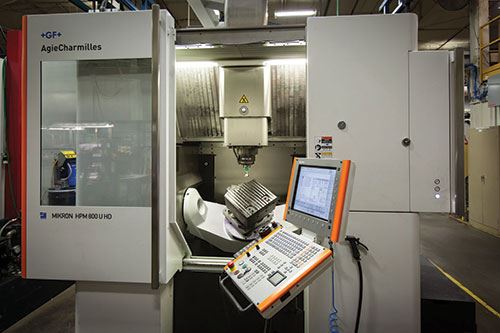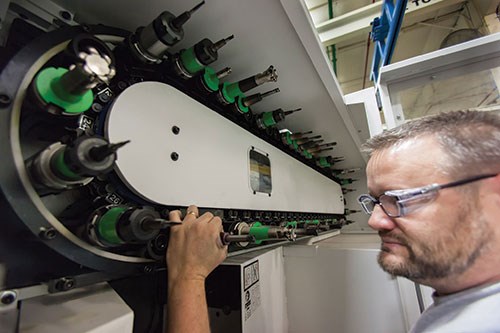Taking the Next Step Toward Five-Axis Efficiencies
This moldmaker’s latest five-axis machining center has improved cycle times and surface finish on certain parts while freeing older machines to process other work.
Although G.H. Tool & Mold’s original five-axis equipment remains just as busy as ever, the shop now favors a newer machine with greater precision and speed. Yet, the reason why involves more than just raw machining capability. Compared to the swivel-head configuration of the previous models, the newer machine’s trunnion-type design is better suited for the shop’s work. Overall, the machine has provided faster cycles, improved throughput and smoother surfaces that require less polishing, says Danny Straatmann, programming manager.
Five-Axis Foundations
G.H. Tool & Mold purchased its first five-axis machine in 2002 and its second in 2004. By that point, the Washington, Missouri, company had been successfully supplying aluminum die cast molds and replacement parts to mostly automotive industry customers for more than 30 years. However, five-axis capability significantly accelerated competitiveness. For example, cutting complex features without angle heads or additional setups not only saved time cutting cores and cavities, but enabled the shop to rely more on milling and less on sinker EDM. Moreover, Straatmann says the machines opened the door to diversifying into aerospace work when business slowed down in the late 2000s.
Today, the 150-employee company is busier than ever, and not just due to the general rebound in the automotive industry. As automakers design lighter vehicles to conserve fuel and reduce emissions, they increasingly opt for cast components rather than stamped ones. G.H. Tool & Mold has been happy to deliver. Most jobs involve 6- to 12-cavity components with tolerances ranging from ±0.0005 to ±0.002 inch. Cycle times range from 30 minutes to 8 hours.
Five-axis machining has proven critical to handling the in-creased demand, Straatmann says, and the shop began seeking additional capacity in 2012. That year, the company installed what has since become its primary five-axis workhorse: a Mikron HPM 800U-HD from GF Machining Solutions (Lincolnshire, Illinois).
A Natural Fit
Although the shop tested other trunnion-type models, the Mikron was a natural choice, Straatmann says. After all, the company had come to rely heavily on that brand by the time it began looking for a new five-axis machine. The bulk of work undergoing three-axis, high-speed machining operations runs across some combination of six Mikron high-speed machining centers.
These three-axis VMCs share many of the very same features that attracted G.H. Tool and Mold to the five-axis HPM 800U-HD, Straatmann says. For instance, a monobloc (single casting) polymer granite base is said to help damp vibration and improve thermal stability. For precise positioning, the machines also feature absolute optical linear glass scales with measuring step of 0.02 micron on the X, Y and Z axes.
Straatmann says he considers the Mikrons to be “fast movers” for both soft and hard machining (46-48 Rc) of smaller, lighter components, and the five-axis HPM 800U-HD is no exception. Featuring oil-lubricated ceramic hybrid bearings, the machine’s Step-Tek HSK A63 in-line spindle generates 63.7 foot-pounds of torque at 4,450 rpm for high metal removal rates, and a maximum speed of 20,000 rpm for operations requiring smooth surface finishes.
Another notable feature is a 60-tool magazine that is angled close to the spindle rather than straight along the side of the machine to speed tool changes. Moreover, the magazine door won’t close if any tool is longer than the machine can accommodate. The machine’s high dynamics (HD) technology delivers 1G acceleration rates, and rapid traverse is 1,771.7 ipm in the X and Y axes and 1,378 ipm in Z.
Straatmann adds that the shop also benefits from GF Machining Solutions’ “Smart Machine” CNC control functions. For instance, the CNC automatically detects any imbalance in cutting tools, whether that occurs during a job or when an operator improperly balances a tool for high-speed machining. The machine either stops or switches to a properly balanced tool when G acceleration levels exceed a value specified by the user. This prevents damage to parts as well as the spindle itself.
However, the shop wasn’t convinced by technology features alone. For one, it helped that the HPM 800U-HD would be inherently familiar to operators used to running its three-axis cousins. Additionally, both the machine builder and St. Louis-based distributor Hartwig had already demonstrated a solid record of service and support. And, of course, the machine met the one requirement the shop had at the outset of its search: a trunnion-type configuration.
Trunnion Over Swivel
Even with the addition of a trunnion-type, the shop’s original swivel-head five-axis machines are as busy as ever, Straatmann says. In addition to capacity constraints, that’s largely because their work envelopes are larger than that of the HPM 800U-HD. This makes them well-suited for big structural and suspension part molds as well as most aerospace components.
However, even larger molds might require smaller core and cavity inserts, intricate features and deep cavities. For much of this work, the machines’ spindle heads are large enough to impede access to the workpiece. Longer tools could remedy this problem, but only at the risk of losing some degree of rigidity. Depending on the length of the overhang, the result could range from a broken tool to the need for additional polishing to clean up blend lines, Straatmann says.
The HPM 800U-HD experiences no such problems. Rather than angling the spindle around the workpiece, the machine angles the workpiece around the spindle. This configuration improves access to part features and facilitates the use of shorter tools for more rigid machining. It also enables faster cutting because there is less mass to move around compared to the original machines and their large spindle heads, Straatmann says.
As a result of these advantages and the machine’s raw capabilities, the shop has evaluated every part run on the older swivel-type models to see if it would be better suited for the Mikron. In addition to improving surface quality, the newer machine has significantly reduced average cycle times on many of these components. “If a part fits within the travels, we run it on that machine,” Straatmann says.
Related Content
The Trifecta of Competitive Toolmaking
Process, technology and people form the foundations of the business philosophy in place at Eifel Mold & Engineering.
Read MoreFive-Axis Graphite Mill With Automation Debottlenecks Electrode Machining
Five-axis electrode cutting enabled Preferred Tool to EDM complex internal screw geometry on an insert that otherwise would have had to be outsourced.
Read MoreSpeed, Productivity Gains and High Uptime Ease Decision for Second Five-Axis Machine
Byrne Tool + Design reduced setups and gained speed and productivity thanks to fast, accurate and compact five-axis CNC machining centers.
Read MoreMachining Center Spindles: What You Need to Know
Why and how to research spindle technology before purchasing a machining center.
Read MoreRead Next
How to Use Continuing Education to Remain Competitive in Moldmaking
Continued training helps moldmakers make tooling decisions and properly use the latest cutting tool to efficiently machine high-quality molds.
Read MoreReasons to Use Fiber Lasers for Mold Cleaning
Fiber lasers offer a simplicity, speed, control and portability, minimizing mold cleaning risks.
Read MoreAre You a Moldmaker Considering 3D Printing? Consider the 3D Printing Workshop at NPE2024
Presentations will cover 3D printing for mold tooling, material innovation, product development, bridge production and full-scale, high-volume additive manufacturing.
Read More.jpg;maxWidth=970;quality=90)


















.jpg;maxWidth=300;quality=90)










